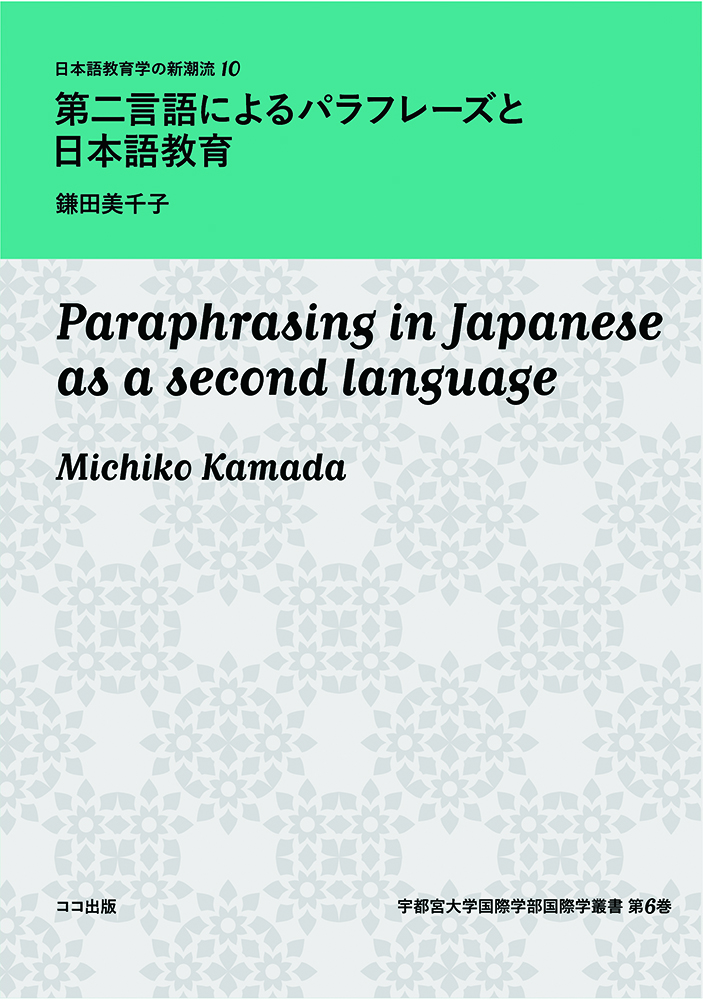
Title
New Trends in Japanese Language Education 10 Dainigengo ni yoru Paraphrase to Nihongo-Kyoiku (Paraphrasing in Japanese as a Second Language and Japanese Language Education)
Size
152 pages, A5 format, hardcover
Language
Japanese
Released
February 23, 2015
ISBN
978-4-904595-56-5
Published by
Coco Publishing
Book Info
See Book Availability at Library
Japanese Page
This book deals with the acquisition of paraphrasing ability from the perspective of Japanese language education for international (i.e., non-Japanese) students. Validation was performed for each of the following aspects: (1) difficulty of text, (2) nominalization, (3) writing style, (4) abstraction from concrete examples, and (5) implicit meaning. Based on the findings, considerations for actual educational methods are presented, along with a discussion of the issues involved.
“Paraphrasing,” in this book, means changing a certain expression into another in accordance with the speaker’s and writer’s intentions, information recipients, communication style, genre, and so on. It also refers to the paraphrased expression itself. Generally, language skills are divided into four major parts: “listening,” “speaking,” “reading,” and “writing.” In actual communication settings, however, people frequently express to the other party details of what he or she has heard or read (in other words, “writing something that one has heard” or “speaking about something that one has read”). In such situations, one must be able to convert written language into spoken language, or vice versa, and abstract concrete details. Consider writing a report for a class at university, for example. The student does not write verbatim what he or she has heard the professor say in class, or what is written in his or her text or reference books. Instead, the student selects expressions that are suitable for the report’s context and the reporting style. Paraphrasing is an indispensable skill in such communication scenarios.
While a native speaker can paraphrase without any conscious effort, the situation is different for international students learning Japanese. They are forced to become conscious of the actual speaking or writing situation and think about how they can best say or write what they need to and the differences between the expressions they might have to use. Here, context is key. In terms of their written reports, theses, and other academic writing, especially, students must use expressions different from those they use in daily conversation. These students become aware of the need for knowledge of written Japanese language and the distance between their current skills and those required to fully understand Japanese as a second language. Thus, the acquisition of paraphrasing skills goes beyond simply memorizing a list of vocabulary and phrases. As such, learning settings must be established to stimulate greater awareness in students of the importance of paraphrasing.
Paraphrasing entails a wide variety of skills such as changing one term to another, transforming a clause or phrase into one word, and condensing the meaning of an entire text into a simple and concise phrase. In conventional Japanese language education, paraphrasing, other than that involving single terms, has been overlooked. Based on the findings concerning the five items listed above, this book places particular focus on the importance of paraphrasing in superordinate concepts related to the concrete and the abstract and paraphrasing that involves implications. These aspects also play a key role in adding depth to all cognitive abilities involving words, including the processes of summarization, quotation, revision, and elaboration. All these involve more than the replacement of words—in fact, they require the verbalization of unsaid or nonliteral meaning. This is the aspect that conventional Japanese language education currently lacks. This book can help to overcome these inadequacies, giving the reader suggestions on how to better support students who face difficulties in learning Japanese.
I trust that this book will help readers understand the key role of paraphrasing in language learning, which goes beyond the traditional framework of the four language skills.
(Written by KAMADA Michiko, Associate Professor, Graduate School of Humanities and Sociology / 2021)



 Find a book
Find a book

